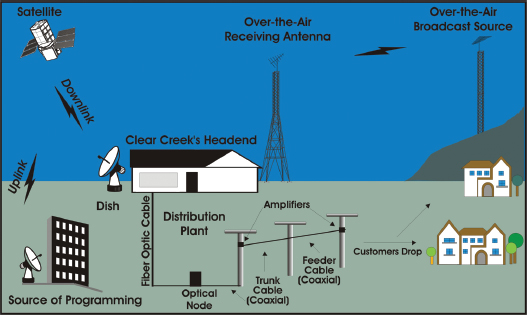The Wires and Satellites behind Cable Television
The idea of using space satellites to receive and transmit communication signals is right out of science fiction: In 1945, Arthur C. Clarke (who studied physics and mathematics and would later write dozens of sci-fi books, including 2001: A Space Odyssey) published the original theories for a global communications system based on three satellites equally spaced from one another, rotating with the earth’s orbit. In the mid-1950s, these theories became reality, as the Soviet Union and then the United States successfully sent satellites into orbit around the earth.

Source: Clear Creek Telephone & Television, www.ccmtc.com.
In 1960, AT&T launched Telstar, the first communication satellite capable of receiving, amplifying, and returning signals. Telstar was able to process and relay telephone and occasional television signals between the United States and Europe. By the mid-1960s, scientists figured out how to lock communication satellites into geosynchronous orbit. Hovering 22,300 miles above the earth, satellites travel at nearly 7,000 mph and circle the earth at the same speed at which the earth revolves on its axis. For cable television, the breakthrough was the launch of domestic communications satellites: Canada’s Anik in 1972 and the United States’ Westar in 1974.
Cable TV signals are processed at a computerized nerve center, or headend, which operates various large satellite dishes that receive and distribute long-distance signals from, say, CNN in Atlanta or ESPN in Connecticut. In addition, the headend’s receiving equipment can pick up an area’s local signals or a nearby city’s PBS station. The headend relays each channel, local network affiliate, or public TV signal along its own separate line. Headend computers relay the channels in the same way that telephone calls and electric power reach individual households: through trunk and feeder cables attached to existing utility poles. Cable companies rent space on these poles from phone and electric companies. Signals are then transmitted to drop or tap lines that run from the utility poles into subscribers’ homes (see Figure 6.1).
Advances in satellite technology in the 1970s dramatically changed the fortunes of cable by creating a reliable system for the distribution of programming to cable companies across the nation. The first cable network to use satellites for regular transmission of TV programming was Home Box Office (HBO), which began delivering programming such as uncut, commercial-free movies and exclusive live coverage of major boxing matches for a monthly fee in 1975. The second cable network began in 1976, when media owner Ted Turner distributed his small Atlanta broadcast TV station, WTBS, to cable systems across the country.